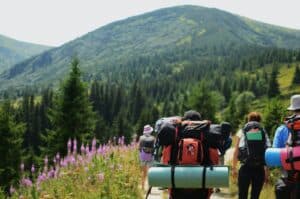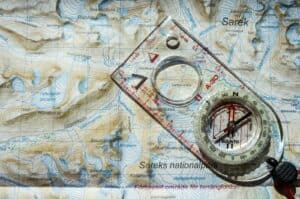I’ve been hitting the trails for years, and I’ve picked up a thing or two about hiking along the way. In this article, I’ll share my best hiking tips that’ll make your next adventure a breeze.
From choosing the right gear to knowing how to navigate, it’s all about preparation and knowledge. So, if you’re ready to step up your hiking game, you’re in the right place.
Choose the Right Gear

When it comes to preparing for hiking, one thing you can’t overlook is choosing the right gear. It makes the trip easier, safer, and far more enjoyable. Here’s what I recommend for your next adventure.
Firstly, get a good pair of hiking boots. Yes, your regular workout shoes might seem fine but they won’t give the support and grip that a dedicated pair of hiking boots can. Look for something waterproof, sturdy yet comfortable, and well-fitted. Remember, blisters are a hiker’s worst nightmare. So, make sure they’re tried and tested before your big day.
Next up, backpacks. The size and type of your backpack will greatly depend on the duration and intensity of your hike. For day hikes, a 20-30 liter pack should suffice. However, for overnight trips, you’ll need something much bigger, typically between 50 and 70 liters. Always opt for backpacks with padded shoulders, waist straps, and multiple compartments.
Remember, the joy of hiking is in walking, not in carrying weights. So, consider lightweight gear. Your pack should ideally not be more than 20% of your body weight. Try to find lightweight alternatives for everything – from your boots to your water bottle.
Let’s talk about the clothing now. Dress in layers. The weather in the mountains can be unpredictable. Your base layer should be moisture-wicking, the middle layer for warmth, and an outer layer for wind or rain protection. Avoid cotton at all costs. Instead, opt for wool or synthetic materials.
A topic hardly any hiker would forget about – hydration and food. Carry enough water and light, high-energy snacks. Hydration packs are a great option as they distribute the weight evenly and keep your hands free. Try to pack food like nuts, dried fruit, and energy bars; they’re light, nutritious, and give that needed burst of energy when fatigue kicks in.
Your gear is your comfort, your safety, and your key to enjoying the journey as much as the destination. And remember, hiking is not only about sweating it out and pushing your limits. It’s about nature, breathtaking views and the peace they bring.
Dress Appropriately for the Trail
Donning the right outfit can make a real difference while you’re hiking. It’s not about just looking the part, but it’s about comfort and safety on the trail. Successful hiking requires preparation and understanding the basics of dressing for the outdoors.
Start with a moisture-wicking base layer. It keeps you dry and eases the process of maintaining body temperature, which is crucial for a comfortable hike. You’ll find materials like polypropylene or merino wool ideal for this base layer.
Layering doesn’t stop with your torso. Choosing the right pants matters, too. They should give you enough freedom of movement, and again, go for materials that are lightweight and breathable. You might want to consider zip-off convertible pants as they can act as shorts when the weather gets warm.
Dressing also extends to your feet. Hikers often underestimate the importance of a good pair of hiking socks. They absorb shock, provide comfort, and prevent the development of blisters. Look for socks made from merino wool or other types of wool, which offer breathability and natural moisture-wicking properties.
Never hit the trail without a sturdy and broken-in pair of hiking boots. Boots should be well-fitted and offer good ankle support. Waterproof boots could come handy on wet or muddy trails.
Last but not least, you should always pack a lightweight, waterproof jacket regardless of the forecast. It provides that extra layer if the temperatures drop or if an unexpected shower hits.
Remember, there is no such thing as bad weather, only inappropriate clothing. Dressing right for hiking is about preparation and adaptability. You can’t control mother nature, but you can certainly prepare for her. So, before you lace up those boots and hit the trail, give your outfit a good thought again.
Pack Light and Efficiently

Shifting gears slightly, let’s delve into packing efficiently for your hiking journey. This can really influence your overall comfort, safety, and, in some instances, the success of your trip.
First and foremost, the lighter your backpack, the easier your hike. Carrying heavy gear can quickly drain your energy and strain your muscles, thereby acting as a deterrent to your hiking enjoyment. But, it’s equally important not to leave out essential items while trying to maintain a lighter load. The trick is to find a balance.
I can’t stress enough how important it is to make a list. Start by jotting down everything you think you might need, then go through this list and carefully scrutinize each item. Only pack what you know you’ll use. If an item doesn’t serve multiple purposes and isn’t essential to your survival, leave it behind.
A standard list may generally include:
- Essential gear (for example, a tent, sleeping bag and pad, stoves)
- Clothes (remember our tips from the previous section!)
- Food and water
- Personal items (don’t forget your toothbrush or toilet paper)
- Basic first aid items
My next tip revolves around how you pack these items into your bag. You want to maximize space and maintain accessibility to frequently used items. Pack your clothes and other lightweight items at the bottom. Your heavier gear should be packed toward the center and upper regions of your bag to distribute the weight effectively.
Stay Hydrated and Fuel Up
After we’ve established the need for appropriate apparel and efficient packing techniques, let’s now highlight another pivotal aspect of hiking – hydration and nutrition. As good as I might be prepared, failing to stay hydrated can swiftly turn a great day outdoors into a struggle for survival.
When I’m hiking, water intake is absolutely vital. Regardless of the difficulty of the trail or the weather conditions, I can’t stress enough on the importance of carrying sufficient water or having a means to purify available water sources on the route. Dehydration can lead to serious complications, including altitude sickness, hypothermia, and even acute mountain sickness in extreme cases.
I’ve witnessed many first-time hikers underestimate the amount of water they might need. A good thumb rule I follow is to bring a minimum of 2 liters of water for a day-long hike. Still, I always make sure to adjust this based on factors like the intensity of the hike and the weather conditions.
Next to hydration, let’s talk about fueling up. It’s crucial to provide your body with the necessary energy to sustain the extensive physical demands of a hike. I make it a point to consume a nutrient-rich meal before setting off on the trail. Additionally, it’s wise to carry easy-to-eat food that can provide instant energy. My pack usually includes:
- Trail mix
- Energy bars
- Fruits
- Nuts and seeds
- Cheese sticks
These easy snacks maintain my energy levels and boost my morale during the hike.
Although your body’s hydration and nutrition needs may vary depending on circumstances, this has been my winning combo on countless trips. So ensure you pack enough water and food to stay fueled and enjoy the hike.
Know Your Limits and Abilities
Equally important to the right gear and proper nutrition on a hike is knowing your personal limits. Not every hiker is made equal, and it’s essential to understand your physical abilities before setting out on a trail. The key to any successful hike is ensuring you’ll be capable of completing it. Start by identifying the strenuousness of the trail you are considering and match that to your current fitness level.
Testing Your Fitness Level
Before you start any hiking journey, it’s advisable to assess your fitness level. I recommend a brisk walk or a short run in your local city park to gauge how you feel afterwards. Feeling out of breath or experiencing sore muscles after a short workout might suggest you’re not quite ready for more challenging trails.
Severe Weather Conditions
Do a quick check of the local weather forecasts as extreme weather conditions can increase the difficulty level of any hike. You might think you’re prepared for a 10-mile trail, only to find yourself caught in heavy rainfall or severe heat midway, turning your hike into a test of physical endurance.
Pay Attention to Altitude
Remember, altitude can also affect your hike dramatically. It’s crucial not to underestimate the effects of altitude sickness—for every 1,000 feet you ascend, the oxygen level decreases by about 3%. If you’re hiking above 8,000 feet and you’re not used to it, you’ll likely feel shortness of breath, mild headache, and fatigue.
Never Over-Exert Yourself
Just as you would not embark on a road trip without knowing how to drive, you should never start a hike beyond your abilities. It’s better to choose a modest, enjoyable hike that’s within your limits. Over-exertion can lead to a myriad of problems like exhaustion, dehydration, or even injuries.
Keeping your abilities in mind is not being negative. It’s being safe and intelligent about your hiking experience. After all, every step towards becoming a more proficient hiker begins with acknowledging and working within your own capabilities.
Plan Your Route and Check the Weather

Conducting thorough research on the trail you’re about to tackle is as important as lacing up a sturdy pair of hiking boots. When planning your route, it’s crucial to consider the length, difficulty, and topography of the trail. Online resources and mobile apps can be incredibly handy in this aspect, providing not only detailed maps and trail descriptions, but also reviews and photos from previous hikers.
Using this information, it’s easier to anticipate the kind of terrain you’ll encounter. You can prepare for steep inclines or rocky paths, and estimate the time it’ll take to complete the hike. Don’t forget to allow buffer time for breaks, meals, and slower than expected progress. Remember: failing to plan is planning to fail. Keep this motto in mind. It can prevent unpleasant surprises and ensure you’re back before dark.
Another critical part of your pre-hike preparation is checking the weather forecast. This is something that should never be overlooked. Weather impacts visibility, safety and your overall hiking experience; therefore, knowing what Mother Nature has in store is beneficial.
There are numerous online platforms and weather apps that provide accurate, up-to-date weather information. Keep an eye out for temperature fluctuations, chances of precipitation, lightnings, and wind speeds. It’s not just about the day of the hike either. Look a few days ahead and after, as weather conditions may impact the condition of the trail.
Lastly, don’t rule out the chance of sudden weather changes, especially in mountainous regions. So even with clear skies projected, don’t underestimate the importance of having your rain gear at hand just in case. At the same time, beware of extreme conditions, like storms or excessive heat. It’s always better to reschedule a hike than to adventure into hazardous situations.
Learn Basic Navigation Skills
In this digital age, it’s easy to rely solely on GPS and smartphone apps. But technology can fail and batteries can run out. That’s where traditional navigation skills come into play. They’re reliable, more intuitive, and fun to master with a little practice.
Your first step is to learn how to read a topographical map, identifying symbols and features such as contour lines (representing changes in terrain), trails, streams, and points of interest. You should understand how to measure distances on the map and correlate them to the actual terrain. A key item to pair with your map is a compass. It will help you navigate when landmarks aren’t visible or in the event you wander off course.
You might wonder, how do I use a compass? It’s straightforward; the red end of the needle points north all the time. Align the compass with your map, point the compass in your intended direction, and you’re set to go. Remember to recalibrate your compass whenever you move into a new area with different magnetic characteristics.
Now let’s talk about pace counting. It is an excellent way to estimate how far you’ve hiked. The magic number for most people is 2,000, the estimated number of steps it takes a person to walk one mile on flat ground.
Apart from these, natural wayfinding techniques can also help. For example, sun rises in the east and sets in the west, moss predominantly grows on the north side of trees, and in the Northern Hemisphere, the stars rotate around Polaris, the North Star.
Learning basic navigation skills may seem daunting at first, but trust me, it’s a worthy investment. When technology fails, when the trail marks are scarce, or when you’re in unfamiliar territory, your knowledge of navigation can be a game-changer. On my next hike, I know I’ll be brushing up on my map-reading and compass using skills. What about you?
Practice Leave No Trace Principles
As we delve deeper into best hiking tips, it’s crucial for me to bring up a cardinal hiking rule: Practicing Leave No Trace Principles. These aren’t just guidelines; they’re an ethical framework for outdoor enthusiasts aiming to minimize their impact on our environment.
Hikers across the globe are increasingly adopting the Leave No Trace Principles. The aim: keeping natural spaces untouched and preserving them for future generations.
Let’s explore these principles:
Plan Ahead and Prepare
The key here is readiness. Gather crucial details about the area you plan to visit. Gather local rules and regulations, trail conditions, weather updates, and more: all these factor into leaving no trace.
Travel on Durable Surfaces
From desert sands to mountain rocks, there are various types of surfaces encountered on a hike. Stick to designated trails and campsite areas. Abiding by this principle will prevent inadvertent damage to flora and fauna.
Dispose Waste Properly
“Pack it in, pack it out” – words to live by. All wastes, including leftover food, should be safely packed and disposed of in designated areas.
Respect Wildlife
While hiking you’ll certainly come across nature’s beautiful creatures. Viewing them from a safe distance respects their autonomy and preserves their habitations. Please refrain from feeding them as human food can harm their dietary health.
Following these points, hiking essentially becomes a spiritual and mindful connection with nature. In the upcoming sections, we’ll delve into more specific tips like equipment checks, training advice, and other preparations. Keep yourself locked onto the idea of sustainable hiking as we continue our journey together.
Be Prepared for Emergencies
Before going any further, I’d like to stress the importance of being prepared for all possible scenarios, especially emergencies that might arise in the course of a hiking trip. The rugged beauty of nature often hides the risks inherent in venturing into the wilderness. And that’s why you need to think ahead, plan accordingly, and make sure you’re prepared for any eventualities.
I’m sure you’re familiar with the saying, “It’s better to be safe than sorry”, right? Exactly, that’s your mantra when it comes to hiking. Emergencies can happen anytime, and they don’t send invites. What’s crucial is how you respond to them which can be a game-changer. Unforeseen circumstances can be a sudden change in weather, getting lost, or even medical emergencies. One thing to keep in mind is quick thinking and fast responses can become your life-savers.
- Pack a First Aid Kit: A first aid kit is a must for any hiking or outdoor trip. Your kit should include materials to treat cuts, scrapes, burns, bites, and injuries from falls or sprains. Don’t forget your personal medications and an emergency blanket. With a well-stocked first aid kit, you’re already a step ahead in dealing with emergencies.
- Learn Basic Survival Skills: Even if you’re on a familiar trail, learning basic survival skills is always beneficial. It includes knowing how to light a fire without matches, finding and purifying water in the wilderness, using a compass and map, among others. It’s these skills, at times, that become the fine line between life and death when caught up in unexpected situations.
- Emergency Contacts and Rescue Signals: Keep a list of emergency contacts. This may include rangers, local authorities, and family. If you’re hiking in a group, make sure everyone has the number of the group leader. Also, know the universal rescue signals, and don’t overlook learning how to use your whistle or mirror to grab attention.
Remember, staying alert and being prepared escalates your self-confidence while hiking. Understanding that emergencies can occur, and knowing how to tackle them boosts not just your safety, but overall hiking experience as well. Equipped with this awareness, let’s move on to explore other important aspects of hiking.
Conclusion: Best Hiking Tips
As we’ve delved into the world of hiking, it’s clear that preparation and respect for our environment are key. Embracing the Leave No Trace Principles isn’t just a nice idea – it’s a necessity. These principles guide us to travel responsibly, dispose of waste properly, and respect wildlife.
But let’s not forget the importance of emergency readiness. Having a well-stocked first aid kit, knowing basic survival skills, and keeping emergency contacts handy are all vital. These precautions don’t just enhance our safety – they also make our hiking adventures more enjoyable.
So, as you lace up your hiking boots and head for the trails, remember these tips. They’ll not only help you have a great hike but also ensure you’re doing your part to protect our beautiful outdoors. Happy hiking!
